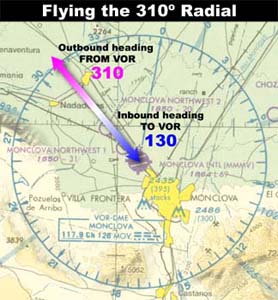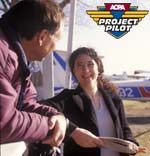| Advertisers
           
Do not reply to this e-mail. Got news? Contact ePilot. Having difficulty using this service? Visit the ePilot Frequently Asked Questions now at AOPA Online or write to [email protected].
Aircraft Owners and Pilots Association
421 Aviation Way
Frederick, MD 21701
Tel: 800/USA-AOPA or
301/695-2000
Copyright © 2006 AOPA. | Training Tips
| | 'RADIAL INBOUND'
What's the difference between a course and a radial when navigating by the VHF omnidirectional range (VOR) system? This confuses many pilots. As flight-training emphasis shifts away from VOR in favor of GPS, do you understand VOR courses and radials so that you can use or explain them properly? The April 4, 2003, Training Tips described how to achieve "VOR virtuosity."  A VOR radiates signals, known as radials, in all directions around the compass rose. While tracking a radial eastbound from the VOR with the omni-bearing selector set to 090, the course deviation indicator centered, and FROM showing on the To/From Indicator, a pilot is flying outbound on the 090-degree radial. So what happens if that pilot turns around and flies that same signal back to the VOR? He is still flying the 090-degree radial. The difference is that he is flying it inbound to the VOR. The needle stayed centered, but now the OBS is set to 270 degrees and the To/From indicator shows TO. Anytime you are flying to a VOR, your course is an inbound course; the radial you are flying is identified by the course outbound. A radial is defined by the Pilot/Controller Glossary as "a magnetic bearing extending from a VOR/VORTAC/TACAN navigation facility." A VOR radiates signals, known as radials, in all directions around the compass rose. While tracking a radial eastbound from the VOR with the omni-bearing selector set to 090, the course deviation indicator centered, and FROM showing on the To/From Indicator, a pilot is flying outbound on the 090-degree radial. So what happens if that pilot turns around and flies that same signal back to the VOR? He is still flying the 090-degree radial. The difference is that he is flying it inbound to the VOR. The needle stayed centered, but now the OBS is set to 270 degrees and the To/From indicator shows TO. Anytime you are flying to a VOR, your course is an inbound course; the radial you are flying is identified by the course outbound. A radial is defined by the Pilot/Controller Glossary as "a magnetic bearing extending from a VOR/VORTAC/TACAN navigation facility." "OK," you say. "I got that wrong, so what? I got home, didn't I?" Perhaps. But misunderstanding causes problems. One way to announce your position to air traffic control is to respond correctly to the instructions, "Say your radial and DME (distance measuring equipment) from the airport." If you are flying inbound and mistake that course for the radial, ATC will look for you 180 degrees from your actual position. Fortunately, ATC knows that this is a common error and usually compensates for it. If this sounds like a mistake you may have made, review "The ABCs of VORs" in the December 2000 AOPA Flight Training. Comprehending the difference between a radial and its reciprocal inbound course could avoid a bear trap on a practical test, earn you a higher score on a knowledge test, and even get you rescued more quickly some day after a mishap. Take the trouble to know!
| Your Partner in Training
| | If two private pilots are on a cross-country flight sharing the responsibilities of the flight, can they both log the flight as PIC (pilot in command) cross-country? This is a common question among the general pilot population, but especially for new pilots. Click here to learn the answer and more about logging PIC time on AOPA Online. Do you have a question? Call the experienced pilots in AOPA's Pilot Information Center at 800/USA-AOPA. They're available to take your calls weekdays 8:30 a.m. to 6 p.m. Eastern. As an AOPA Flight Training Member, you have access to all of the features within AOPA Online and AOPA Flight Training Online. Login information is available online.
| Flight Training News
| | EMBRY-RIDDLE SELLS ACCELERATED TRAINING PROGRAM
Embry-Riddle Aeronautical University has sold its non-degree commercial airline pilot training program, dubbed CAPT, to Flight Training Services International. CAPT was an accelerated ratings program targeted at students who had already earned college degrees but were looking for a career change. ERAU announced in February that it would stop enrolling new cadets in the program so that it could shift focus back to its flagship aeronautical science degree program at its Daytona Beach, Florida, and Prescott, Arizona, campuses. The new owner of CAPT said it will retain the name, training curriculum, and staff, and will continue to operate out of Flagler County Airport in Bunnell, Florida. For more information, see the Web site. In other news, Embry-Riddle announced that interim president John P. Johnson has been named president of the university. Johnson had been in the interim post, as well as serving as provost and chief academic officer, since November 2005. AVIATION EXPLORING AWARDS $22,000 IN SCHOLARSHIPS
The 2006 National Aviation Explorer Scholarship program has awarded $22,000 in scholarships. The scholarship program is sponsored yearly by Aviation Exploring, a youth development program open to young men and women between the ages of 14 and 20. The 2006 recipients were Charles Watson of Lebanon, Tennessee, who received $10,000 toward a degree leading to an aviation profession; Genesis Rivas, San Fernando Valley, California, who received $3,000 toward flight training; Autumn Turner, Fort Wayne, Indiana, who received $3,000 for the avionics category; Daniel Gubernath, Bucyrus, Ohio, $3,000 in the aircraft maintenance category; and Andrew Kocarnik, Lincoln, Nebraska, $3,000 in the aviation management category. Applications for the 2007 scholarships are available on the Web site and must be submitted through a local council by March 31, 2007.
| Inside AOPA
| | AOPA PROJECT PILOT MENTORS READY TO HELP YOU WITH TRAINING
 Having a helpful guide who's been there, too, can be one of the most positive influences on your flight training experience. Sure, your instructor serves as your primary go-to person for information, but an AOPA Project Pilot Mentor can serve as your No. 1 fan. Besides sharing their passion for flight, Mentors can tell you about all the great things they have experienced through aviation and some of the challenges they faced and overcame as student pilots. Since June, when the enhanced Project Pilot program, www.AOPAProjectPilot.org, was unveiled, 1,500 Mentors have signed up, and many are looking for students to help. Visit the Web site today to find one. A student with a Project Pilot Mentor is three times more likely to successfully complete their training. Having a helpful guide who's been there, too, can be one of the most positive influences on your flight training experience. Sure, your instructor serves as your primary go-to person for information, but an AOPA Project Pilot Mentor can serve as your No. 1 fan. Besides sharing their passion for flight, Mentors can tell you about all the great things they have experienced through aviation and some of the challenges they faced and overcame as student pilots. Since June, when the enhanced Project Pilot program, www.AOPAProjectPilot.org, was unveiled, 1,500 Mentors have signed up, and many are looking for students to help. Visit the Web site today to find one. A student with a Project Pilot Mentor is three times more likely to successfully complete their training. HAVE YOU UPDATED YOUR AOPA MEMBER PROFILE?
To make the most of your membership and allow us to serve you better, please visit AOPA Online and update your personal member profile.
| Training Products
| | 'LOST AND CROSSED' OFFERS TIPS TO KEEP YOU ON COURSE
Do you worry about getting lost on a cross-country? If so, you're not alone. Lots of factors can contribute to loss of situational awareness on a cross-country trip. These include haze, strong winds, or over-reliance on a GPS receiver to get you from Point A to Point B. For sensible suggestions on maintaining and reestablishing situational awareness on a cross-country, view the AOPA Air Safety Foundation's Lost and Crossed DVD. The 35-minute presentation includes the use of air traffic control, VORs, and pilotage to keep new and student pilots from getting lost. Lost and Crossed is available through the ASF Store for $19.95 per copy. Note: Products listed have not been evaluated by ePilot editors unless otherwise noted. AOPA assumes no responsibility for products or services listed or for claims or actions by manufacturers or vendors.
| | Final Exam | | Question: When two same-category aircraft are converging on a nontowered airport for a downwind traffic pattern entry for the same runway, which aircraft has the right of way? Answer: In the scenario you describe, if the two aircraft are converging at approximately the same altitude, the aircraft to the other's right has the right of way. For additional rules governing who has the right of way, you'll want to review FAR 91.113. For information on operations at nontowered airports, review Section 4-4-3 of the Aeronautical Information Manual and download the AOPA Air Safety Foundation's Operations at Nontowered Airports Safety Advisor. Got a question for our technical services staff? E-mail to [email protected] or call the Pilot Information Center, 800/872-2672. Don't forget the online archive of "Final Exam" questions and answers, searchable by keyword or topic.
| Picture Perfect
| Looking for some really fabulous aviation photography? All the air-to-air photos and beautifully detailed ground images used by AOPA Pilot magazine over the years are yours at the click of a mouse button. Download your favorite images to use for wallpaper, send an e-postcard, or order prints online. For more details, see AOPA Online.
| What's New At AOPA Online
| What is the outlook for a career as an airline pilot? Are there other jobs in the aviation industry that might offer a flying future-and what do they typically pay? These topics and many others are explored in the newly updated "AOPA's Guide to Flying Careers."
| Weekend Weather
| See the current weather on AOPA Online, provided by Meteorlogix.
| ePilot Calendar
| UPCOMING FLYING DESTINATIONS:
Alliance, Ohio. The Eighth Annual Ohio Aeronca Aviators Fly-In takes place August 18 through 20 at Barber (2D1). Lots of flying, friendship, fun, and a forum or two. On-airport camping and local lodging available. Contact Brian Matz, 216/337-5643, or visit the Web site. Santa Rosa, California. The Wings Over Wine Country Airshow takes place August 19 and 20 at Charles M. Schulz-Sonoma County (STS). Featuring a U-2 Dragon Lady flyby, a C-17 Globemaster III demonstration, and a wing walker. Contact the Pacific Coast Air Museum, 707/575-7900, or visit the Web site. St. Louis, Missouri. The Eighth Annual Joint Bird Strike Committee USA/Canada Meeting takes place August 21 through 24 at the Sheraton St. Louis City Center. Learn what options are available in wildlife management, and what others in the industry are doing to manage situations. Contact 419/625-0242, or visit the Web site. To submit an event to the calendar or to search all events visit AOPA Online. For airport details, see AOPA's Airport Directory Online. FLIGHT INSTRUCTOR REFRESHER CLINICS
The next AOPA Air Safety Foundation Flight Instructor Refresher Clinic is scheduled in Allentown, Pennsylvania, August 26 and 27. Clinics are also scheduled in Sacramento, California; Colorado Springs, Colorado; and Columbia, Maryland, September 9 and 10. For a complete schedule, see AOPA Online. Can't make it in person? Sign up for the CFI Refresher Online. AOPA AIR SAFETY FOUNDATION SAFETY SEMINARS
AOPA Air Safety Foundation Safety Seminars are scheduled in Orono, Maine, September 5; South Portland, Maine, September 6; and Lexington, Massachusetts, September 7. The topic is "Do the Right Thing-Decision making for pilots." For details and a complete schedule, see AOPA Online.
| |